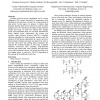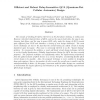195 search results - page 7 / 39 » Design of clocked circuits using UML |
DAC
2000
ACM
14 years 8 months ago
2000
ACM
In this paper we describe an area efficient power minimization scheme "Control Generated ClockingI` that saves significant amounts of power in datapath registers and clock dr...
ISQED
2010
IEEE
14 years 2 months ago
2010
IEEE
Leakage power has grown significantly and is a major challenge in SoC design. Among SoC's components, clock distribution network power accounts for a large portion of chip po...
DAC
2005
ACM
13 years 9 months ago
2005
ACM
In this paper, we analyze the effect of jitter in track and hold circuits. The output spectrum is obtained in terms of the system function of the track and hold. It is a fairly g...
ISLPED
2003
ACM
14 years 1 months ago
2003
ACM
A significant fraction of the total power in highly synchronous systems is dissipated over clock networks. Hence, low-power clocking schemes would be promising approaches for futu...
DFT
2006
IEEE
13 years 11 months ago
2006
IEEE
The concept of clocking for QCA, referred to as the four-phase clocking, is widely used. However, inherited characteristics of QCA, such as the way to hold state, the way to synch...


